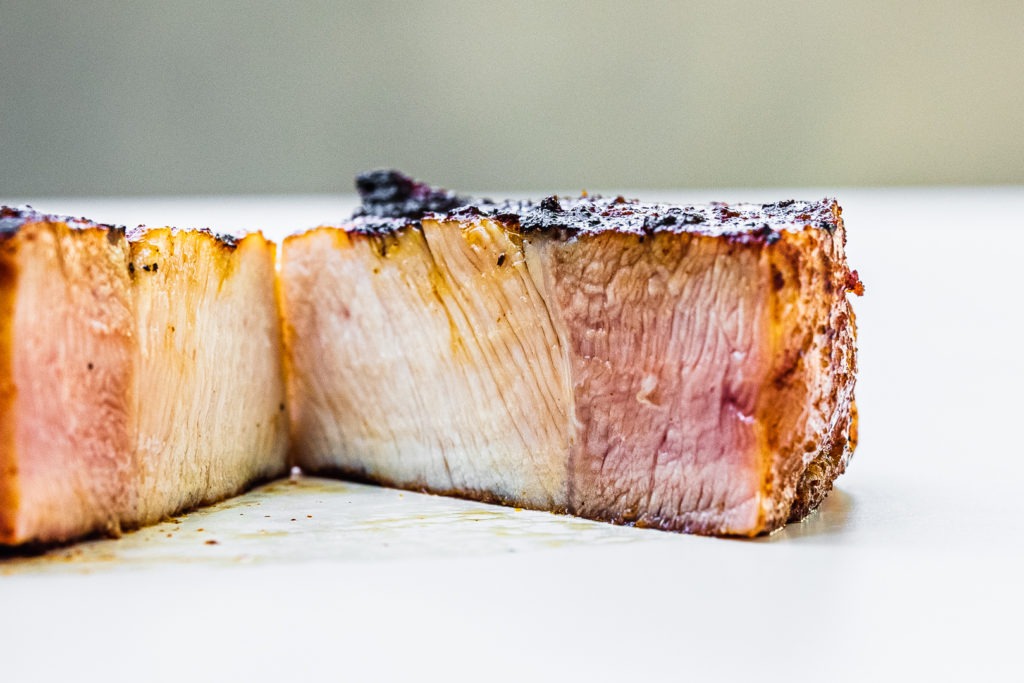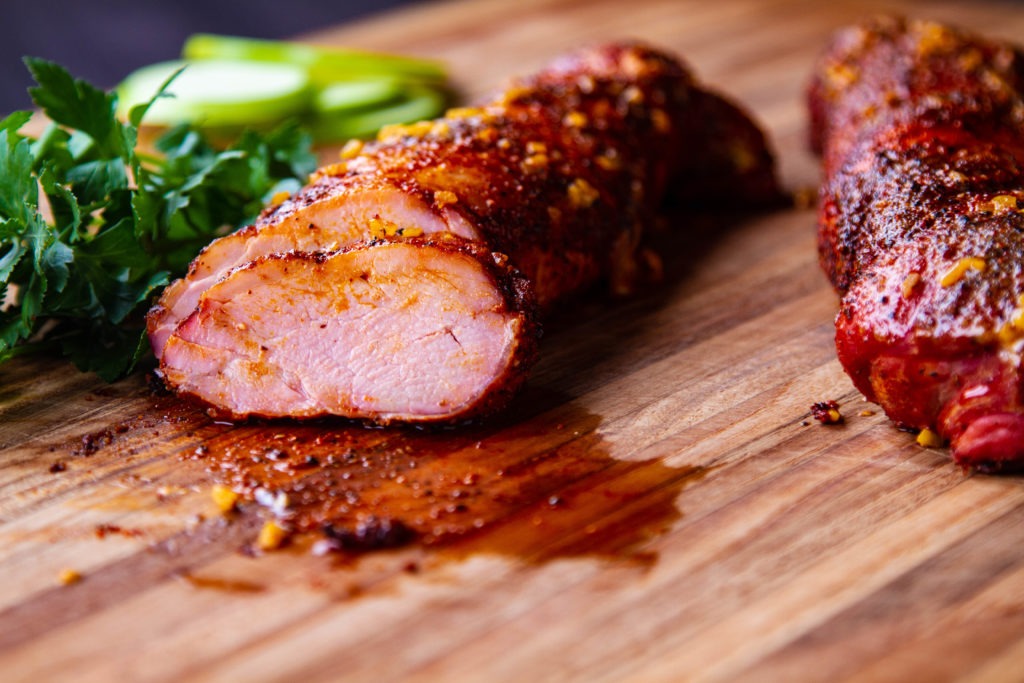When our grandmothers and grandfathers were growing up, there was a real threat to their health that we don’t face anymore. No, I’m not talking about the lack of antibiotics, nor the scarcity of nutritious food. It was trichinosis, a parasitic disease that used to be caught from undercooked pork.
The legitimate worry of trichinosis led their mothers to cook their pork until it was very well done. They learned to cook it that way and passed that cooking knowledge down to their offspring, and so on down to us. The result? We’ve all eaten a lot of too-dry, overcooked pork.
But hark! The danger is, for the most part, past, and we can all enjoy our pork as the succulent meat it was always intended to be. With proper temperature control, we can have better pork than our ancestors ever dreamed of. Here, we’ll look at a more nuanced way of thinking about pork temperatures than you’ve likely encountered before.
Table 1 – Internal Color of Cooked Pork Loin Chops
|
Pork Quality
|
Endpoint Temperature and Time at that Temperature
|
|
|
|
145°F (63°C), 3min
|
160°F (71°C), 1sec
|
|
Normal
|
Pink
|
Very Slightly Pink
|
|
Normal-injected
|
Pink
|
Very Slightly Pink
|
|
PSE
|
Slightly Pink
|
Tan/White
|
:max_bytes(150000):strip_icc()/__opt__aboutcom__coeus__resources__content_migration__serious_eats__seriouseats.com__recipes__20160630-pork-tenderloin-sous-vide-5-doneness-composite-1500x1125-37252779e14a4021aa8267d04d3e16c2.jpg)
Food safety concerns and thermal thoughts about pork-cooking temperatures
As I said before, the thing that drove our ancestors to overcook their pork was the fear of trichinosis. But that is a fear that we don’t need to share for two reasons.
First, hog-raising practices have changed and are now mandated to be safer. According to the CDC, “The number of [trichinosis] cases decreased beginning in the mid-20th century because of legislation prohibiting the feeding of raw-meat garbage to hogs,” which basically eliminated the presence of the trichinella parasite in the hogs that we consume. In fact, the majority of trichinosis cases now come from undercooked wild animals, not farm-raised pork. (Wild carnivores and omnivores are the main modes of transmission.)
Second, even if we fear those parasites from our farm-raised hogs, there is a thermal hack to get around them. Freezing cuts of pork that are six inches thick or less to 5°F (-15°C) for 20 days eliminates any trichinella worms that may have somehow gotten into the flesh. Now, 20 days seems like a long time, but when I see a good sale on pork, I tend to stock up, and that pork can easily remain in my freezer for 20 days. When it emerges, it is going to be free of all trichinella, for sure. Well, it will if my freezer goes down to 5°F (-15°C), which I can verify with my ChefAlarm® leave-in probe thermometer.
(Note that the freezing trick may not work for wild game, as they can be infected with parasites that do not die off in those conditions. Continue to cook your game well.)
If we eliminate the hazard of parasitic infection, all we’re left with is the standard risk of bacterial infection.
Conduct with me, if you will, a thought experiment. Imagine cooking a steak. To what temperature do you cook it? I usually aim for nothing higher than 135°F (57°C). You feel comfortable with your steak temperature, I assume, sure in your knowledge that steak is safe when cooked to that lower temperature.
But think of this: the USDA recommended doneness temp for beef cuts is 145°F (63°C). That’s right, the USDA says you should shy away from anything less than medium-well.
With the freezer-assured elimination of parasitic infection, we have put pork on the same footing as beef, and I, for one, regularly flout the USDA’s recommendations for beef temps. And here’s my own kitchen secret: I also flout them for pork.
Now, you may be shaking your head, or your screen, or your faith in my advice, but hear me out. Medium-cooked pork loin is delicious. It’s juicy, it’s tender, it has an amazing texture, and it lacks that saw-dusty chewiness of overcooked pork. And some cuts, especially the tenderloin, are even better cooked as low as medium-rare.
Naturally, this option is not for everyone. Yes, technically there is risk. But there is risk with every steak, too—that’s why at every steakhouse there is that little warning at the bottom of the menu absolving the restaurant from liability: “the consumption of raw or undercooked potentially hazardous foods may result in foodborne illness.” If you or your loved ones are immunocompromised, if for safety reasons you should not be eating rare-ish meats at all, then don’t try this.
Every day, we weigh the risks of any and every food that we eat, and for me, the benefits outweigh the risks on this one most of the time.
Pink pork is ok! At least, it can be.
First, let’s get one thing straight: color is not an indicator of doneness, nor of safety. If, for instance, you were to brine a pork loin with some curing salt, it will always be pink, no matter to what temperature you cook it. (That’s basically what Canadian bacon or peameal bacon is.) And a well-done pork loin that has suffered time and temperature abuse after cooking by sitting on the table too long is no longer safe to eat, even though it is not pink at all.
If we can’t rely on color to tell us what is safe, what can we use? Temperature! The USDA calls for pork to be cooked to 145°F (63°C) for food safety—much lower than the 160°F (71°C) that many people think is the cutoff for pork—and a quick reading with a Thermapen® ONE can tell us right away if our pork has achieved that safe temperature.
If you cook your meat slowly so there is little to no temperature gradation as you move from the outside to the inside, you will end up with meat that is significantly pinker throughout than if you pump the heat in quickly, “overcooking” the outside of the pork as the middle approaches perfect temp.


PINK PORK Experiment – Is Pink Pork GOOD!?
FAQ
Is it OK to eat pink pork?
How can you tell if pork is undercooked?
What Colour should cooked pork be?
Is pork supposed to be pink or white?
